Iannis Xenakis at the REDCAT 2011

REDCAT (Walt Disney Concert Hall)
Los Angeles, California
January 28-30, 2011
Friday, January 28, 2011
Presented by the Center for Experiments in Art, Information and Technology, the first night of this three-day festival kicked off in a surprising manner with one of Xenakis’ pioneering and legendary electro-acoustic works, “Diamorphoses” (1957-58), which employed the sounds of jet planes, crashing railroad cars, Earthquake shocks, a tiny Greek bell, etc. to form very dense, dark clouds and giant, downwardly-circling sonic webs. It sounded very impressive in a multi-channel context, although, as I sat front and center, I was puzzled why the music only emanated from the speakers on the right side of the hall. Nevertheless, a wise choice to not include any kind of visuals made it much easier to concentrate on the sound.

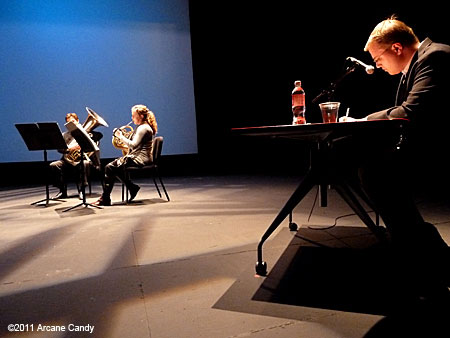
I always enjoy listening to music I’ve never heard before–especially live. “Dmaathen” (1976) was the first of three new-to-me pieces on the menu tonight. It combined a raspy, snarling, droning oboe with dry, precise outbursts of percussion, including marimba, xylophone and drums. Another of Xenakis’ early tape works, “Orient Occident” (1960), came next, and sounded much better than “Diamorphoses,” as it poured out of speakers on both sides of the theater and swirled around the audience members’ heads. This piece is considered a classic from the first decade of electronic music. It’s made of such sounds as a cello bow rubbed over a cardboard box, metal rods and gongs, ionosphere signals and a greatly slowed-down excerpt from Xenakis’ instrumental work, “Pithoprakta.”

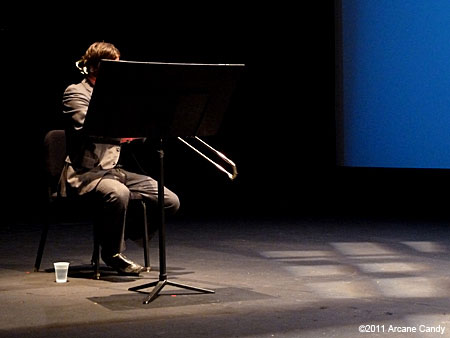
In “Linaia-Agon” (1972), a trombone battled a horn and a tuba in a series of blats, squawks and drones that sounded like a war between a motorcycle and a pack of elephants. The show was completed with a half-hour slab of Xenakis-inspired turntablism by DJ Sniff. (Don’t worry, you couldn’t dance to it.) As he scratched some vintage Xenakis vinyl, Mr. Sniff fed the resulting sounds into various electronic gadgets, from which he produced layers upon layers of skittering samples that sounded like Xenakis on steroids. Although it was a good performance, it reminded me of how much I love the sublime subtlety of Xenakis’ original electro-acoustic works.

Saturday, January 29, 2010
On night two, no less than three pieces for cello were scattered throughout the program, including “Nomos Alpha” (1965-66) and “Kottos” (1977), which were solo, and “Charisma” (1971) for cello and clarinet. The odd sound realm produced by Xenakis’ s scores included some odd-sounding glissandi up and down the fretless board, low-pitched saw drones, barely-there wind wisps and chattering taps and tussles. Although I enjoyed it, I would have preferred one cello piece and two more of some other instruments for variety.

“Achorripsis” (1956-57) called for a large 21-piece ensemble, who picked (and not exactly grinned), plucked and sawed off a full range of super-quirky stop-and-start avant-garde classical. A slightly smaller 11-piece ensemble realized “Analogique A + B” (1958-1959), which was somewhat similar to Achorripsis, but with added electronic gurgles and blasts of noise. The program closed with the rarely performed “Pour la Paix” (1981) for dancers, singers and electronic sound. Almost all of the piece took place in pitch dark, as the dancers struck poses while their camping headlamps formed pretty patterns on the wall and alternately blinded the audience.
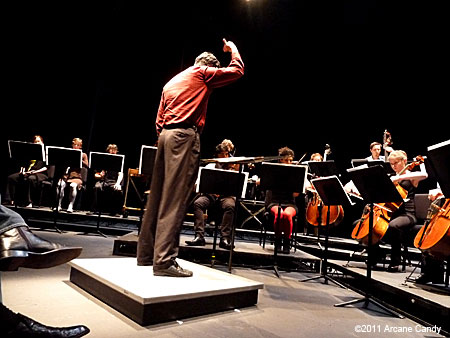

Speaking of the audience, after the first piece, some guy who sat in the seat on my left told me to stop taking photos because he said it was distracting, despite the fact I had already tried to be as considerate and polite as possible by turning off my flash and sound at the very beginning, and I held the camera, which is a tiny point-and-shoot model, literally on my lap the entire time. I never lifted it up once. Unfortunately, the applause died down and everything got quiet before I could debate the issue with him, but at least he moved three seats away before the next piece began.
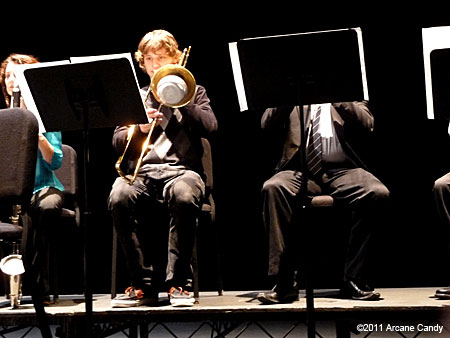

Then the same thing happened again way later, right before the last piece, when another guy two seats to my right complained about the same thing. I asked him what he does when someone coughs, sneezes or shuffles around in their chair, but of course, he couldn’t come up with a better answer than, “It’s just distracting.” I replied, “That’s ridiculous!” and put my camera away. I can’t believe that people as overly-sensitive as these two would even like Xenakis’ music, much less attend a concert of it. Then again, I wouldn’t be surprised if they’re music professors.
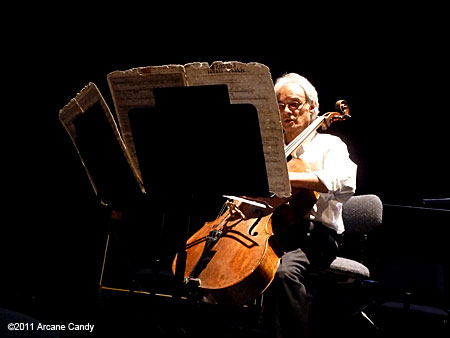
Sunday, January 30, 2011
The third and final night started off with a suite of Xenakis-inspired electro-acoustic music called “Flicker Tone Pulse” (2000-2010) by Curtis Roads. Divided up into seven sections, it unfurled a rushing hailstorm of granular flurries, sour synth stabs and distant echoes that wouldn’t sound out of place on an INA-GRM or empreintes DIGITALes CD. Three or four of the segments were perfectly matched by videos in which rapidly fluctuating abstract lines, shapes and paint splatters were put on prominent display.

The rest of the night featured Xenakis works, starting with “Dikhthas” (1979), which meshed a snarling, raspy violin with some stark, invigorating piano pound ‘n’ tinkle. “Epicycles” (1989) called for a 14-piece ensemble that put their instruments through the paces with all sorts of stop-and-start, lurching, screeching and droning 20th century dissonance and even a homely melody or two thrown in here and there. A slightly smaller 10-piece outfit continued in a similar way with “Akanthos” (1977).
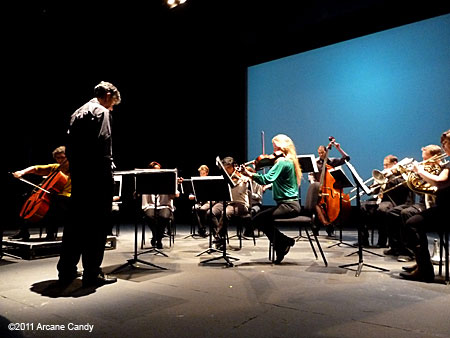
This whole can of worms festival got closed the same way it opened: with another one of Xenakis’ classic electroacoustic works. “Polytope de Cluny” (1972) sent the audience ambling down through an endless array of squeaking doors inside a massive cave full of pinging metal raindrops and deep rumbles that dramatically climaxed with an incredibly loud, screaming cloud of scintillating sound flurries. Again, no visuals accompanied the piece and none were needed. I can’t think of a better ending for this awesome three-day Xenakisfest.
Text and photos ©2011 Arcane Candy
Leave a Reply